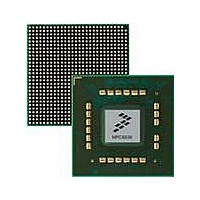MPC8536DS Freescale Semiconductor, MPC8536DS Datasheet - Page 92

MPC8536DS
Manufacturer Part Number
MPC8536DS
Description
BOARD DEV SYSTEM MPC8536E
Manufacturer
Freescale Semiconductor
Series
PowerQUICC III™r
Type
MPUr
Datasheets
1.MPC8536EBVTAVLA.pdf
(127 pages)
2.MPC8536EBVTAVLA.pdf
(1706 pages)
3.MPC8536DS.pdf
(2 pages)
4.MPC8536DS.pdf
(126 pages)
Specifications of MPC8536DS
Contents
Board, Software and Documentation
Processor Series
MPC85xx
Core
e500
Data Bus Width
32 bit
Maximum Clock Frequency
667 MHz
Operating Supply Voltage
- 0.3 V to + 1.21 V
Maximum Operating Temperature
+ 105 C
Data Ram Size
32 KB
Interface Type
SPI, USB
Program Memory Type
DDR2, DDR3, SDRAM
Core Size
32 Bit
Program Memory Size
544KB
Cpu Speed
1.5GHz
Digital Ic Case Style
BGA
No. Of Pins
783
Supply Voltage Range
0.95V To 1.05V
Rohs Compliant
Yes
For Use With/related Products
MPC8536
Lead Free Status / RoHS Status
Lead free / RoHS Compliant
High-Speed Serial Interfaces
The Common Mode Voltage is equal to one half of the sum of the voltages between each conductor of a balanced interchange
To illustrate these definitions using real values, consider the case of a CML (Current Mode Logic) transmitter that has a common
mode voltage of 2.25 V and each of its outputs, TD and TD, has a swing that goes between 2.5V and 2.0V. Using these values,
the peak-to-peak voltage swing of each signal (TD or TD) is 500 mV p-p, which is referred as the single-ended swing for each
signal. In this example, since the differential signaling environment is fully symmetrical, the transmitter output’s differential
swing (V
mV and –500 mV, in other words, V
(V
2.20.2
The SerDes reference clock inputs are applied to an internal PLL whose output creates the clock used by the corresponding
SerDes lanes. The SerDes reference clocks for PCI Express are SD1_REF_CLK and, SD1_REF_CLK. The SerDes reference
clocks for the SATA and SGMII interfaces are SD2_REF_CLK and, SD2_REF_CLK.
The following sections describe the SerDes reference clock requirements and some application information.
2.20.2.1
Figure 58
92
DIFFp
6.
•
•
) is 500 mV. The peak-to-peak differential voltage (V
Common Mode Voltage, V
The supply voltage requirements for X2V
SerDes Reference Clock Receiver Reference Circuit Structure
— The SDn_REF_CLK and SDn_REF_CLK are internally AC-coupled differential inputs as shown in
A Volts
OD
B Volts
shows a receiver reference diagram of the SerDes reference clocks.
) has the same amplitude as each signal’s single-ended swing. The differential output signal ranges between 500
Each differential clock input (SDn_REF_CLK or SDn_REF_CLK) has a 50-Ω termination to SGND (xcorevss)
followed by on-chip AC-coupling.
SerDes Reference Clocks
SerDes Reference Clock Receiver Characteristics
MPC8536E PowerQUICC III Integrated Processor Hardware Specifications, Rev. 3
Figure 57. Differential Voltage Definitions for Transmitter or Receiver
SD n _TX or
SD n _RX
SD n _TX or
SD n _RX
peak. For example, the output differential peak-peak voltage can also be calculated as V
= 2*|V
circuit and ground. In this example, for SerDes output, V
/ 2, which is the arithmetic mean of the two complimentary output voltages within a differential
pair. In a system, the common mode voltage may often differ from one component’s output to the
other’s input. Sometimes, it may be even different between the receiver input and driver output
circuits within the same component. It is also referred as the DC offset in some occasion.
OD
OD
cm
|.
is 500 mV in one phase and –500 mV in the other phase. The peak differential voltage
Differential Peak-Peak Voltage, V
DD
Differential Swing, V
Differential Peak Voltage, V
are specified in
DIFFp-p
) is 1000 mV p-p.
Table 2
ID
or V
DIFFpp
and
OD
DIFFp
= 2*V
= A – B
Table
= |A – B|
cm_out
DIFFp
3.
= V
(not shown)
SDn_TX
Freescale Semiconductor
V
+ V
cm
= (A + B) / 2
SDn_TX
Figure
TX-DIFFp-p
= (A + B)
58.










